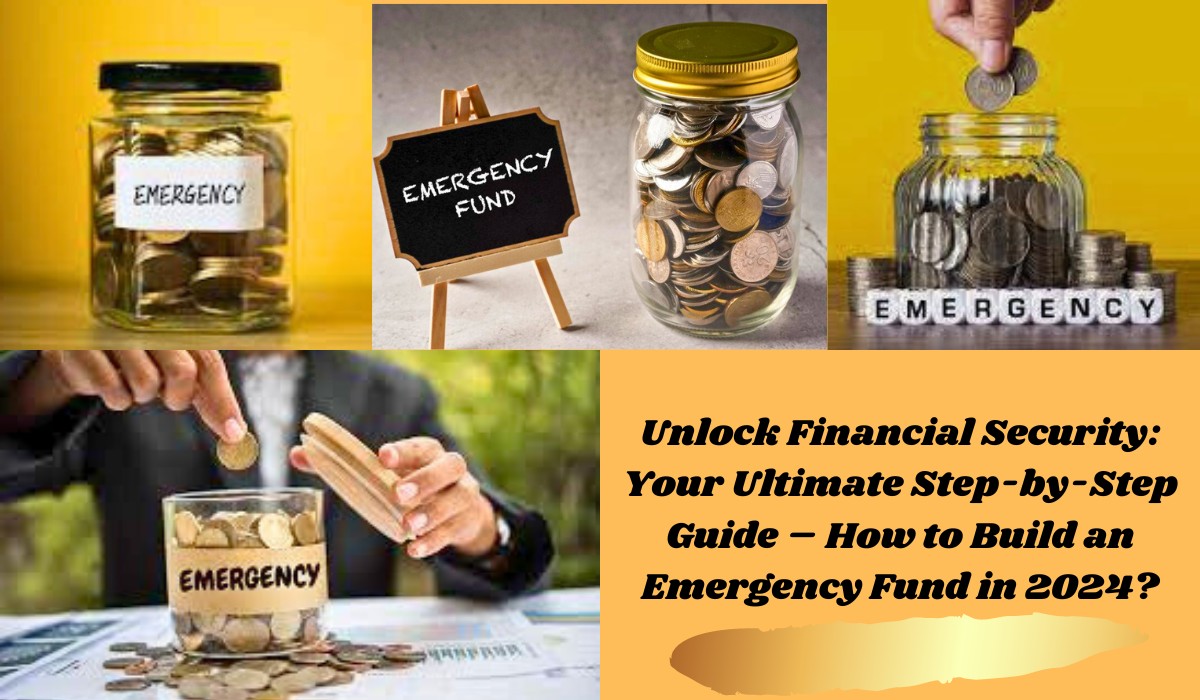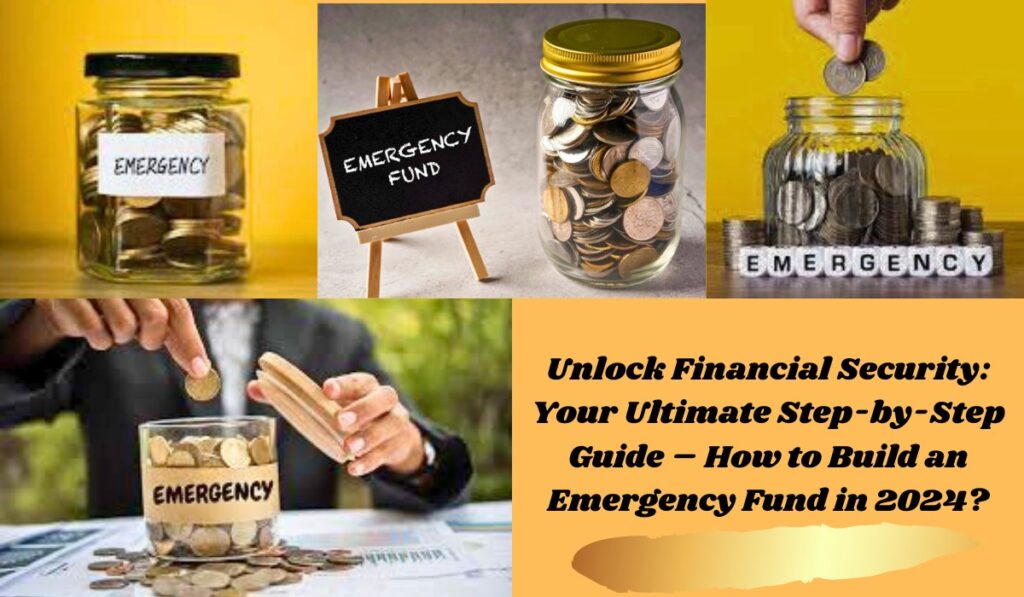Unlock Financial Security: Your Ultimate Step-by-Step Guide – How to Build an Emergency Fund in 2024?

Description
Learn how to establish a robust emergency fund with our detailed step-by-step guide. Uncover practical tips, expert strategies, and actionable steps to create a financial safety net that shields you from unforeseen expenses.
Life is unpredictable, and unexpected costs can arise at any moment. Whether it’s a medical emergency, an abrupt job loss, or an urgent car repair, having a financial safety net can make all the difference. That’s where an emergency fund comes into play. In this guide, we’ll guide you through the steps to build an emergency fund, ensuring you’re ready for whatever life throws your way.
Problem: The Consequences of Not Having an Emergency Fund
Many individuals live paycheck to paycheck, leaving them vulnerable to financial shocks. Without an emergency fund, you may rely on credit cards, loans, or even dip into retirement savings to cover unexpected expenses. This can lead to:
- Debt Accumulation: High-interest credit card debt can accumulate rapidly, making it challenging to pay off balances and resulting in long-term financial strain.
- Financial Stress: Constantly worrying about unplanned expenses can affect your mental and physical health.
- Missed Opportunities: Without a financial cushion, you may have to forgo important opportunities, such as investing in education or seizing time-sensitive deals.
Real-Life Examples of Financial Hardships
Consider the case of Sarah, a single mother who lost her job during the COVID-19 pandemic. Lacking an emergency fund, she quickly depleted her savings and had to rely on high-interest payday loans to cover basic living expenses. Within months, she found herself trapped in a cycle of debt, struggling to keep up with payments while searching for a new job.
Unfortunately, Sarah’s story is not unique. According to a 2023 report by the Federal Reserve, nearly 40% of Americans would find it difficult to cover a $400 emergency expense. This underscores the critical need for a financial buffer.

Solution: Step-by-Step Guide to Building an Emergency Fund
Building an emergency fund may seem overwhelming, but with a clear plan, it’s entirely achievable. Here’s how you can get started:
1. Set a Realistic Savings Goal
The first step in building an emergency fund is to determine how much you need to save. A common recommendation is to have three to six months’ worth of living expenses set aside. However, your specific goal will depend on your financial situation, job security, and lifestyle.
- Calculate Your Expenses: Begin by adding up your monthly essential expenses, including rent/mortgage, utilities, groceries, and transportation.
- Set a Target: Multiply your total monthly expenses by the number of months you wish to cover. For example, if your monthly expenses are $3,000, you should aim to save between $9,000 and $18,000.
| Monthly Expenses | 3-Month Target | 6-Month Target |
| $2,000 | $6,000 | $12,000 |
| $3,000 | $9,000 | $18,000 |
| $4,000 | $12,000 | $24,000 |
2. Create a Budget to Identify Savings Opportunities
Once you have a savings goal in mind, the next step is to create a budget that enables you to set aside money each month.
- Track Your Spending: Review your bank statements to understand where your money is going. Categorize your expenses into essentials (e.g., rent, groceries) and non-essentials (e.g., dining out, entertainment).
- Cut Back on Non-Essentials: Identify areas where you can reduce spending. This might involve cooking at home more often, canceling unused subscriptions, or finding cheaper alternatives for everyday expenses.
- Automate Your Savings: Set up automatic transfers from your checking account to a savings account designated for your emergency fund. This ensures that you’re consistently saving without needing to think about it.
3. Start Small and Build Momentum
You don’t need to save the full amount overnight. The key is to start small and gradually increase your savings over time.
- Set Initial Milestones: Begin with a smaller goal, such as saving $1,000. This initial cushion can help cover minor emergencies and motivate you to continue building your fund.
- Celebrate Progress: Each time you reach a savings milestone, take a moment to acknowledge your achievement. This positive reinforcement can keep you motivated.
4. Boost Your Savings with Additional Income
If your budget is tight, consider exploring ways to increase your income to accelerate the savings process.
- Side Hustles: Take on a part-time job, freelance work, or gig economy opportunity to earn extra cash. As mentioned in our previous article on side hustles, platforms like Upwork, DoorDash, and Fiverr provide flexible options to supplement your income.
- Sell Unused Items: Declutter your home and sell items you no longer need. Websites like eBay, Facebook Marketplace, and Poshmark make it simple to turn unwanted goods into cash.
- Use Windfalls Wisely: Tax refunds, bonuses, and gifts can all be added to your emergency fund to help you reach your goal more quickly.
5. Keep Your Emergency Fund Separate
It’s essential to maintain your emergency fund separate from your regular checking account. This minimizes the temptation to dip into it for non-emergencies.
- High-Yield Savings Account: Consider opening a high-yield savings account for your emergency fund. These accounts offer higher interest rates than standard savings accounts, allowing your money to grow more rapidly.
- Avoid Investments: While it may be tempting to invest your emergency fund in stocks or other high-return options, it’s crucial to keep this money in a safe, easily accessible account. The goal is to have quick access to funds without the risk of losing value.
6. Regularly Review and Adjust Your Fund
Your emergency fund isn’t a “set it and forget it” situation. Life circumstances change, and so should your savings strategy.
- Reevaluate Your Needs: Periodically assess your expenses and adjust your savings target as needed. For instance, if your rent increases or you take on additional financial responsibilities, you may need to boost your funds.
- Replenish After Use: If you have to draw from your emergency fund, prioritize replenishing it as soon as possible.
Conclusion
Take Control of Your Financial Future
Building an emergency fund is one of the most crucial steps you can take to secure your financial future. By setting a realistic savings goal, creating a budget, and consistently contributing to your fund, you can shield yourself from unexpected expenses and alleviate financial stress. Remember, it’s not about how much you start with, but about making steady progress over time. Start today, and take control of your financial future with confidence.
References
- Federal Reserve Report on Financial Well-Being (2023) – Provides data on the financial resilience of U.S. households and the importance of emergency savings.
- Federal Reserve Report
- Bankrate Survey on Emergency Savings – Offers insights into how Americans are saving for emergencies and the challenges they face.
- Bankrate Survey


